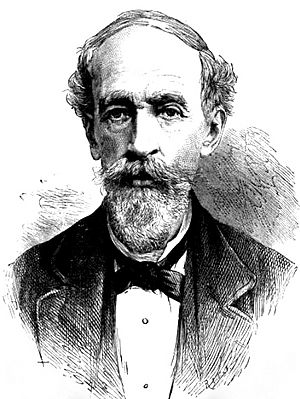John Penn (engineer) facts for kids
Quick facts for kids
John Penn
|
|
|---|---|

John Penn
|
|
| Born | 1805 |
| Died | 1878 Lee, Kent
|
| Nationality | British [English] |
| Occupation | Engineer |
| Spouse(s) | Ellen English (m. 1847) |
| Engineering career | |
| Institutions | Royal Society Institution of Mechanical Engineers |
| Significant advance | High-power oscillating engine Trunk engine Lignum vitae stern bearing (with Francis Pettit Smith) |
John Penn (1805–1878) was a brilliant English engineer. His company became super important in the mid-1800s. This was because he invented new ways to make ship engines and propellers. His firm became the main supplier for the Royal Navy. This happened as the Navy changed from sailing ships to steam-powered ones. John Penn also led the Institution of Mechanical Engineers twice.
Contents
Early Life and Family
John Penn was born in 1805 in Greenwich, England. His father, also named John Penn, was an engineer too. In 1799, his father started a business. It focused on machines for farms, especially mills for grinding grain. This business grew to be one of the biggest in London.
John Penn joined his father's company when he was young. In the early 1830s, he became a partner. The company was then called John Penn and Sons. When his father passed away in 1843, John Penn took over completely. He had already been managing the company for several years.
Building Better Engines
John Penn was a great inventor. One of his first inventions was the "grasshopper beam engine." A small version of this engine powered the machines in his own factory.
Penn soon changed his company's focus to marine engines. These are engines for ships. He built 40-horsepower engines for paddle steamers like the 'Ipswich' and 'Suffolk'. These were likely his first ship engines.
Amazing Engine Inventions
Penn worked on making the "oscillating engine" much better. In 1844, he replaced the engines in the Admiralty yacht, HMS Black Eagle. He used his new oscillating engines. They had double the power but took up the same space and weight. This was a huge achievement! It meant his company became more important than older engine makers.
Penn also introduced "trunk engines" for ships with screw propellers. HMS Encounter (1846) and HMS Arrogant (1848) were the first ships to get these engines. They worked so well that by 1878, 230 ships had them. In 1852, the famous ship SS Great Britain also got Penn's modern oscillating engines.
Because of his amazing inventions and reliable engines, Penn became the main supplier for the Royal Navy. His work helped the Navy switch from wind power to steam power.
Penn also helped invent wooden bearings for screw-propeller shafts. These were made from a very hard wood called lignum vitae. This invention was super important. It allowed steam-powered ships to travel long distances across oceans without problems. He worked with Francis Pettit Smith on this idea.
Engines for Warships
John Penn also designed the trunk engine for HMS Warrior. During the Crimean War, the Navy needed many gunboats quickly. Penn was asked to design engines for them. He chose his trunk engine design. His company then made 90 sets of these engines. They were the first mass-produced, high-power marine engines.
The Navy insisted that all parts use the same measurement standards. Penn was good friends with Joseph Whitworth, who developed these precise tools. This friendship helped Penn mass-produce engines. An old newspaper article from 1887 described how Penn quickly made 90 engines in 90 days. This feat amazed other countries.
An engine from the shipwrecked SS Xantho is a gunboat type engine. It was built in 1861 and is the only one known to exist. It was found with all its parts and Penn's nameplate still attached. You can see it at the Western Australian Museum.
John Penn's company was a big employer in Greenwich. At its busiest, 1800 people worked there. His company was known as the best-equipped marine engineering factory. Penn was also a good boss. He gave pensions and Christmas gifts to his skilled workers. His company also trained many future marine engineers.
Later Life and Legacy
John Penn became a member of the Institution of Mechanical Engineers in 1848. He was its president twice, from 1858–1859 and again from 1867–1868. In 1859, he was chosen as a Fellow of the Royal Society. This is a very high honor for scientists and engineers.
In 1860, Penn helped start the Royal Institution of Naval Architects.
In 1872, Penn's two older sons joined the business. Penn became less involved and fully retired in 1875. Towards the end of his life, he became paralyzed and later blind. He still traveled by steam yacht to places like France and Italy.
John Penn passed away on September 23, 1878, at his home in Lee, London. He was buried at St Margaret's Church. A local newspaper called him 'Greenwich's greatest son'. By the time he died, his company had built engines for 735 ships. These ranged from small river ferries to huge battleships.
John Penn is still remembered in Greenwich today. There is a John Penn Street, and the Penn Almshouses were built in his memory. His old house, The Cedars, also still stands.
Personal Life
In 1847, John Penn married Ellen English. She was 21 years younger than him. They had four sons: John, William, Frank, and Alfred (Dick). His eldest son, John, became a Member of Parliament. His sons Frank, William, and Dick all played cricket for Kent. Penn also had two daughters.

